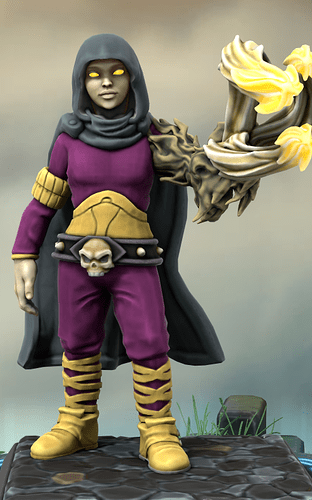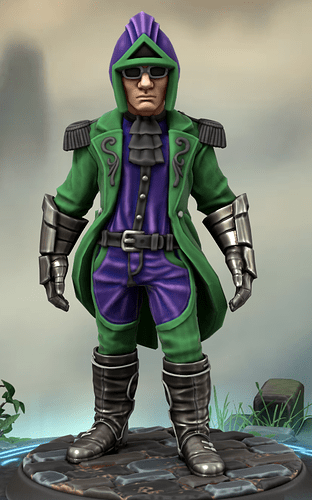History of Venture Comics, Pt. 5: The Height of the Silver Age (1962-1966)
Throughout the mid-60s, Venture Comics continued to grow and expand, with crossovers becoming more common and longer-form storylines beginning to take shape across many of its stories. In 1963, a new publishing deal led to Venture having the option for up to twelve titles a month, which they quickly expanded to, picking up eleven main titles and restarting Cryptic Trails as a Wild West comic, which proved to be a mistake; its characters proved unpopular, and it struggled for just over four years before being cancelled in 1967.
During this period, Venture Comics blended its various themes. Science fiction stories increasingly relied on dimensional aliens rather than the outer cosmos of Celestial Travels, and magical forces clashed with technological ones on a regular basis. Venture into the Unknown increasingly began to focus on stories in which two or more heroes who rarely interacted joined forces against an established foe or pair of foes, with fewer and fewer attempts to create new heroes; the Drifter was the last new hero to gain a foothold.
History of Venture Comics, Pt. 6: The Venture Trinity (1967-1969)
By the late 1960s, societal trends were changing, and Venture Comics was changing with them. Many of the ideas that had seemed evergreen were now growing more complex, and Venture Comics struggled to remain relevant within the Comics Code, with over half of its titles in danger of outright failure and the company running towards rocky ground. In 1967, a new Editor-in-Chief came to Venture Comics. Harold Mossby was a veteran of the publishing industry, with big ideas and a willingness to challenge authority that led him to lay out a three-year plan to revitalize the struggling business. His proposal became known as the Venture Trinity.
The Venture Trinity began in 1967, with revisions to the Big Three of Venture Comics. The most notable revision was the Death of Flatfoot storyline, leading into the new version of the robotic hero, but Mossby also began a new arc for Skybreaker Stories, unceremoniously dropping the “magical foe seeking Skybreaker’s spear” storyline that had been bubbling without resolution for the past nine years, and began a more socially-conscious Madame Liberty that began to interact with the Summer of Love and the rise of the Hippie Movement, more sympathetically than in the past few years of her comic.
The second major event came at the dawn of 1968 with Dimensional Devastation. In the aftermath of the event, the teams involved were all shuffled around. Doctor Cosmos left the Vanguards to explore the newly available dimensions alongside Neutrino and Wavelength, as the Celestial Traveller. In her place, Fission and Nucleon joined the Vanguards, with nothing left to defend in Santa Juanita. Reactors and Cryptic Trails were both cancelled, opening the door for what were meant to be two new heroes born out of the chaos - although neither of them would ultimately gain any traction.
Finally, in 1969, Mossby closed out the last of Venture’s bi-monthly productions, cancelled the two struggling new titles, and replaced them with a new Champions of Truth lineup and one last attempt at a new hero, Dark Rivers, which proved more popular than its predecessors. Along the way, Mossby also stunned long-time readers by finally cancelling Venture into the Unknown, using the grand reboot of the Champions of Truth as a send-off for the publication. He reasoned that Hidden Champions would take on the stories of heroes crossing over, and the anthology introducing new heroes was no longer needed.
With its lines revamped and new stories on the horizon, Venture was now in its Bronze Age, and was ready to begin struggling against the strictures of the Comics Code…
Behind the Scenes
Historical and metafictional discussion time! This is long, so apologies
So, first off, you may notice that a few dates have changed. While writing up this section, I discovered that I had done math wrong, resulting in Flatfoot #300 being listed as a full year later than it should have been. While fixing that, I discovered a number of other errors, so a lot of comic titles have had to be revised in the final timeline. Most of the dates are the same, but Dimensional Devastation had to be slid forward one month to end on Celestial Travels #350 in April 1968.
Secondly, and this is just a little thing, but I kind of like that we have our first utterly abandoned storyline! I had mentioned in Skybreaker’s writeup that he was contending with a shadowy villain who was trying to steal his spear, and then I didn’t actually get around to writing that villain. So it goes away. Whoosh.
Now, looking ahead! Historically, the Bronze Age doesn’t have a well-defined start date, but various comic events throughout 1970 and 1971, along with the revision of the Comics Code in 1971 to be more permissive, are generally viewed as the transition period. When I was making notes about Sentinel Comics, I pegged 1970 as the start of the Bronze Age in the metaverse, with the beginning of Conflux and Battle Unending, the end of The Indestructible Bunker, and the Mad Bomber Baron Blade story in 1971.
Recently, Christopher and Adam suggested that the Bronze Age starts a bit earlier for Sentinel Comics, kicking off with Moonfall in late 1968. As a result, I’ve moved my own Bronze Age forward a year to 1970, and extended the events beforehand a bit. Moonfall is doubly unusual in that it’s the first limited-run series for Sentinel Comics; more would start popping up a lot in the 70s. In our world, limited-run series didn’t start until 1979, so I’m going to have to start tracking my issues more carefully to include some of these. Which is, to be honest, going to be fun.
A second thing of note - compared to real-world publishing companies, Sentinel Comics is small in the Silver Age, and doesn’t grow much in the Bronze. Adam mentioned in a recent podcast that realistically, based on their metaverse popularity and reach, Sentinel Comics should probably have about twice as many titles as they actually do. I think he’s, if anything, understating the situation.
For real-world comparisons: up until 1964, Marvel was only able to publish eight superhero titles a month; they gradually increased from 1964 to 1969 until they were up to sixteen. DC, I think, was publishing twelve superhero comics monthly in 1960, and by 1969 seems to have been publishing anywhere from sixteen to twenty-one titles a month, with an evenly larger number of titles, but many of them popping up bi-monthly or quarterly. By the end of the Bronze Age, Marvel published 25 in-universe titles plus five licensed titles a month; DC ramped up to an even higher number, but then had to cancel a whole lot at the end of the 70s and restructure.
Sentinel Comics, however, starts the Silver Age with only eight titles, one of which doesn’t start as a superhero comic and one of which, The Indestructible Bunker, is riding the line between superhero and war comic. In 1964, they cancel Arcane Tales to drop to seven, in 1965 they launch Arcane Tales Vol. 2 and Stranger in a Strange World to rise to nine, but but then they cancel Stylin’ Shirley in 1966 to go back down to eight, and Stranger in a Strange World in 1967 to end the Silver Age with only seven titles. And unlike Sentinel’s extraordinarily low Silver Age hero-count, which can be kind of explained as “the C-listers and D-listers of that age haven’t been written up”, this has been consistently presented as the full publication list.
In the Bronze Age, Sentinel Comics grows and then shrinks again. In 1970, they add an eighth title, and start doing limited runs on a regular basis, effectively giving them nine monthly titles. They grow to ten in 1973 and eleven in 1975, replacing cancelled titles with new ones along the way, then shrink back down to ten in 1977 and to nine in 1978. In 1980, they’re back up to ten through the transformation of Mystery Comics to twice a month. But that’s still only nine to eleven monthly titles for the entirety of the Bronze Age. Even if we assume a couple of failed titles for minor C-list or D-list heroes we don’t know about, that’s quite a bit less than half what Marvel or DC was putting out.
I had originally said that Venture was mostly a single-digit titles company. Obviously, as we have reached twelve monthly titles, that has not fully succeeded, and we’ve technically bypassed Sentinel Comics’ output. I’m going to keep our total number of titles small in the Bronze Age, but I’m probably going to add one or two slots, which means that Venture always put out a few more titles than Sentinel did despite being a smaller publishing company footprint-wise. Such is the wibblies!
With this update, we’re back to M-F updates kicking off the Bronze Age, so see you Monday for our first new hero.



